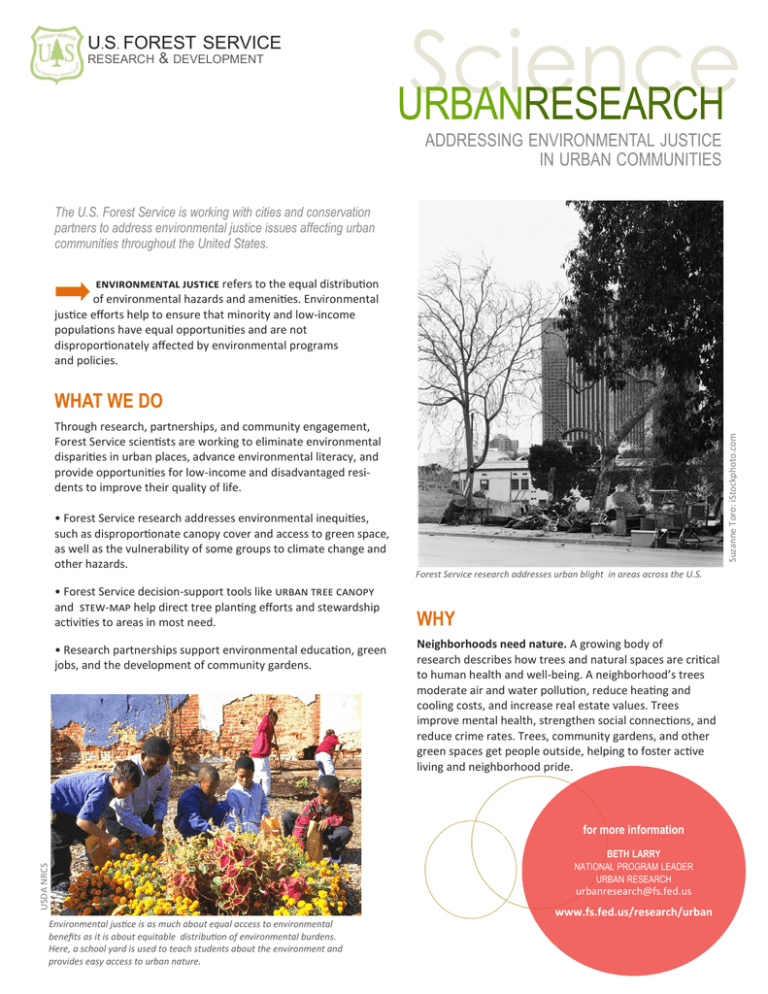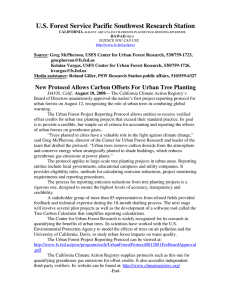Science URBAN RESEARCH
advertisement

U.S. FOREST SERVICE RESEARCH & DEVELOPMENT Science URBANRESEARCH ADDRESSING ENVIRONMENTAL JUSTICE IN URBAN COMMUNITIES The U.S. Forest Service is working with cities and conservation partners to address environmental justice issues affecting urban communities throughout the United States. background environmental justice refers to the equal distribution of environmental hazards and amenities. Environmental justice efforts help to ensure that minority and low-income populations have equal opportunities and are not disproportionately affected by environmental programs and policies. WHAT WE DO • Forest Service research addresses environmental inequities, such as disproportionate canopy cover and access to green space, as well as the vulnerability of some groups to climate change and other hazards. • Forest Service decision-support tools like urban tree canopy and stew-map help direct tree planting efforts and stewardship activities to areas in most need. • Research partnerships support environmental education, green jobs, and the development of community gardens. Suzanne Toro: iStockphoto.com Through research, partnerships, and community engagement, Forest Service scientists are working to eliminate environmental disparities in urban places, advance environmental literacy, and provide opportunities for low-income and disadvantaged residents to improve their quality of life. Forest Service research addresses urban blight in areas across the U.S. WHY Neighborhoods need nature. A growing body of research describes how trees and natural spaces are critical to human health and well-being. A neighborhood’s trees moderate air and water pollution, reduce heating and cooling costs, and increase real estate values. Trees improve mental health, strengthen social connections, and reduce crime rates. Trees, community gardens, and other green spaces get people outside, helping to foster active living and neighborhood pride. USDA NRCS For Environmental justice is as much about equal access to environmental benefits as it is about equitable distribution of environmental burdens. Here, a school yard is used to teach students about the environment and provides easy access to urban nature. For more for more information BETH LARRY NATIONAL PROGRAM LEADER URBAN RESEARCH urbanresearch@fs.fed.us www.fs.fed.us/research/urban URBANRESEARCH RESEARCH HIGHLIGHTS Prioritizing environmental justice: urban tree canopy decision tool. Forest Service scientists at the Northern Research Station have developed high-resolution land cover mapping methods to measure the presence or absence of trees and vegetation in low-income urban areas, where predominately minority populations live. The urban tree canopy tool (UTC) helps decision-makers prioritize where to plant trees. Environmental equity is a key criterion, in addition to other priorities like asthma, physical activity, crime, flooding, summer heat, noise pollution, and social cohesion. By providing accessible data to redress environmental justice issues, UTC enhances the ways in which city officials can incorporate minority and low-income communities into sustainability planning and decision processes. http://nrs.fs.fed.us/urban/utc/ Cultivating green jobs and better livelihoods in NYC. In partnership with the Million Trees NYC Campaign, a joint initiative of the New York City Department of Parks and Recreation and the nonprofit New York Restoration Project, the Forest Service has invested $2 million into a program that is: (1) stimulating the economy by financially empowering low-income residents, (2) enhancing the urban environment through the restoration of trees and forests, and (3) improving science-based understanding of the impacts of green jobs programs as pathways out of poverty. At least 50 young adults from low-income communities in New York City have so far been employed into good paying jobs, working together to restore the city’s urban ecosystems. http://www.nrs.fs.fed.us/nyc/focus/environmental_literacy/ green_collar_jobs/ Contaminated fish: understanding risk perceptions among anglers of color in Chicago’s Calumet region. The consumption of sport-caught fish is a pressing social, economic, and public health issue in places where water and sediment quality are low or variable, such as in the industrialized Calumet region of northwest Indiana and southeast Chicago. A Forest Service study suggests that Black and Latino anglers in this area are likely to be disproportionately affected by contaminated fish. Research makes it clear that existing advisories and detailed fish consumption risk information are failing to reach the diverse angler community. Westphal, L.M. et al. 2008. Anglers’ appraisals of the risks of eating sport-caught fish from industrial areas: lessons from Chicago’s Calumet region. Research in Human Ecology 15(1): 46-62. Map illustrating the city of Baltimore’s urban tree canopy prioritization based on social, economic, and ecological criteria. Latino park access: an examination of environmental equity in Georgia. Immigrant and minority access to outdoor, natural places in the South is an important consideration for urban park managers because of the many social benefits associated with park access. Recent Forest Service research in southeastern Georgia suggests that Latinos need to live in more integrated, middle and upper-income neighborhoods in order to have access to recommended levels of parkland. Information from this study can be used to inform park planning at the municipal and county levels, to not only help improve access for Latino populations but to encourage their involvement in the planning process. Johnson-Gaither, C. 2011. Latino park access: examining environmental equity in a ‘new destination county’ in the South. Journal of Park and Recreation Administration 29(4): 37-52. helping communities transition to a sustainable future. Urban Research at the U.S. Forest Service provides leading science and decision tools to inform urban natural resources stewardship and improve environmental health and community well-being in urban areas. Our research helps to create more livable, desirable, sustainable communities. February 2013



